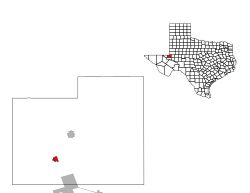Wink, Texas facts for kids
Quick facts for kids
Wink, Texas
|
|
|---|---|

Texas State Highway 115 in Wink
|
|
 |
|
| Country | United States |
| State | Texas |
| County | Winkler |
| Area | |
| • Total | 1.17 sq mi (3.02 km2) |
| • Land | 1.17 sq mi (3.02 km2) |
| • Water | 0.00 sq mi (0.00 km2) |
| Elevation | 2,792 ft (851 m) |
| Population
(2020)
|
|
| • Total | 915 |
| • Density | 782.05/sq mi (301.95/km2) |
| Time zone | UTC-6 (Central (CST)) |
| • Summer (DST) | UTC-5 (CDT) |
| ZIP code |
79789
|
| Area code(s) | 432 |
| FIPS code | 48-79768 |
| GNIS feature ID | 1371804 |
Wink is a small city located in Winkler County, Texas, United States. In 2020, about 915 people lived there. Wink is known as a childhood home of the famous singer and songwriter Roy Orbison. He once described life in Wink as being all about "football, oil fields, oil, grease and sand."
Contents
History of Wink
Wink started in 1926 when a lot of oil was found in the Hendrick oilfield nearby. By mid-1927, the Wink Townsite Company began selling land. Many people moved to Wink because of the oil boom. There weren't enough houses, so newcomers often lived in tents or quickly built homes.
How Wink Got Its Name
The town was first called Winkler, after the county. But when people asked for a post office, they found out another town already had that name. So, the citizens decided to shorten the name to Wink, and they got their post office in 1927.
Early Days and Growth
In 1927, the first public school was built, and a Sunday school also started. The town grew very quickly. By November 1927, about 3,500 people lived in Wink. This number jumped to 6,000 by 1929. Some people think the actual population might have been as high as 10,000 to 25,000 during the oil boom!
Challenges and Changes
The fast growth also brought some problems. The city government, which started in June 1928, had some issues. A judge had to declare the election invalid, and the city government was reorganized. In December 1928, the town built its first official building, which was a jail. In 1929, the Texas-New Mexico Railroad built tracks to Wink, connecting it to other towns like Monahans.
Wink Through the Years
After the big oil boom, the population of Wink started to go down in the 1930s. It stayed under 4,000 people. By 1933, Wink was officially a legally recognized town. At one point, there were five hospitals and fifteen doctors to help people working in the oil fields or dealing with sickness.
The population continued to decrease in the 1940s, from 1,945 to 1,521. In December 1947, the Winkler County State Bank opened in Wink. By the 1950s, Wink had a stable community with over 1,500 people. However, the railroad that connected Wink to Wink Junction was removed in 1958.
In the early 1960s, the population briefly went up to over 1,800 but then dropped again. In July 1960, the U.S. government gave Wink over a million dollars to improve the city. This money was used for things like paving roads and adding curbs.
The population kept declining in the 1970s and 1980s, staying under 1,200. Even though the oil economy got a bit better in the late 1970s, the number of businesses in Wink became very low. By the end of the 1980s, Wink had a small budget. In 1990, 1,189 people lived in Wink. This number went down to 919 by 2000 but slightly increased to 940 in 2010. The 2020 census showed 915 residents.
Geography and Weather
Wink is located at 31°45′16″N 103°9′15″W / 31.75444°N 103.15417°W. The city covers about 1.2 square miles (3.02 square kilometers), and all of it is land.
Climate in Wink
Wink is often one of the hottest places in the United States during summer. Temperatures can often go above 105°F (41°C). It's common for temperatures to reach over 110°F (43°C) every summer.
Population Details
| Historical population | |||
|---|---|---|---|
| Census | Pop. | %± | |
| 1930 | 3,963 | — | |
| 1940 | 1,945 | −50.9% | |
| 1950 | 1,521 | −21.8% | |
| 1960 | 1,863 | 22.5% | |
| 1970 | 1,023 | −45.1% | |
| 1980 | 1,182 | 15.5% | |
| 1990 | 1,189 | 0.6% | |
| 2000 | 919 | −22.7% | |
| 2010 | 940 | 2.3% | |
| 2020 | 915 | −2.7% | |
| U.S. Decennial Census | |||
Who Lives in Wink?
| Race | Number | Percentage |
|---|---|---|
| White (NH) | 554 | 60.55% |
| Black or African American (NH) | 7 | 0.77% |
| Native American or Alaska Native (NH) | 2 | 0.22% |
| Some Other Race (NH) | 1 | 0.11% |
| Mixed/Multi-Racial (NH) | 15 | 1.64% |
| Hispanic or Latino | 336 | 36.72% |
| Total | 915 |
According to the 2020 United States census, there were 915 people living in Wink. These people made up 314 households and 262 families.
Education in Wink
Students in Wink attend schools that are part of the Wink-Loving Independent School District. All of Winkler County, where Wink is located, is also part of the area served by Odessa College.
Famous Person from Wink
- Roy Orbison, a well-known singer and songwriter, grew up in Wink.
See also
 In Spanish: Wink (Texas) para niños
In Spanish: Wink (Texas) para niños

